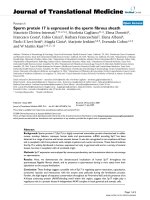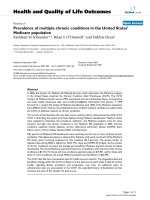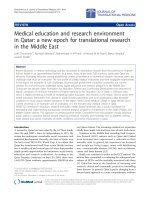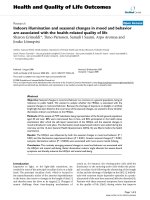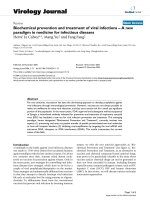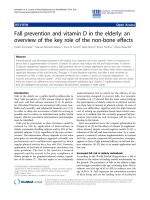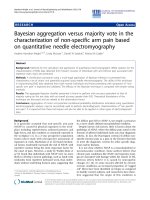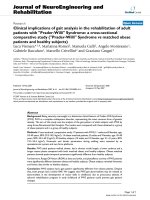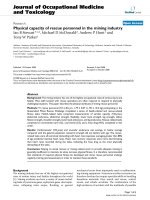báo cáo hóa học:" Medical education and research environment in Qatar: a new epoch for translational research in the Middle East" doc
Bạn đang xem bản rút gọn của tài liệu. Xem và tải ngay bản đầy đủ của tài liệu tại đây (445.5 KB, 8 trang )
REVIEW Open Access
Medical education and research environment
in Qatar: a new epoch for translational research
in the Middle East
Lotfi Chouchane
1*
, Ravinder Mamtani
1
, Mohammed H Al-Thani
2
, Al-Anoud M Al-Thani
2
, Marco Ameduri
1
,
Javaid I Sheikh
1
Abstract
Recent advances in medical technology and key discoveries in biomedical research have the potential to improve
human health in an unprecedented fashion. As a result, many of the Arab Gulf countries, particularly Qatar are
devoting increasing resources toward establishing centers of excellence in biomedical research . However, there are
challenges that must be overcome. The low profile of private medical institutions and their negligible endowments
in the region are examples of such challenges. Business-type government controlled universities are not the
solution for overcoming the challenges facing higher education and research programs in the Middle East.
During the last decade, Qatar Foundation for Education, Science and Community Development has attracted six
branch campuses of American Institutions of higher learning to the Education City in Qatar, a 2500-acre area,
which is rapidly becoming a model of integrating higher education and research in the region. Not-for profit, time-
tested education institutions from abroad in public-private partnership with local organizations offer favorable
conditions to build robust research programs in the region. Weill Cornell Medical College in Qatar (WCMC-Q) of
Cornell University is an example such an institution. It is the first and only medical school in Qatar.
WCMC-Q’s interwoven education, research and public health based framework lays a sturdy foundation for
developing and implementing translational medicine research programs of importance to the State of Qatar and
Middle Eastern nations. This approach is yielding positive results. Discoveries from this program should influence
public policy in a positive fashion toward reducing premature mortality and morbidity due to diabe tes, obesity,
heart disease and cancer, examples of health conditions commonly encountered in Qatar.
Introduction
A monarchy, Qatar has been ruled by the Al-Thani family
since the mid-1800 s. Since its independence in 1971, the
nation has undergone remarkable social, economic and
industrial development. Recently, the State of Qatar won
the bid to host 2022 FIFA World Cup. It is evident that
Qatar has transformed itself from a poor British territory
into a wealthy oil and natural gas rich state that provides
ample growth opportunities for businesses, social events,
education and research institutions. According to t he
Qatar Statistics Authority, on Sept. 30, 2010, the re were
1,642,235 Qatari residents, approximately 350,000 of who
are Qatari citizens. The remaining residents are expatriates
chiefly from South Asia and from non-oil-rich Arab states.
Countries in the Middle East including Gulf Coopera-
tion Council (GCC) nations such as Qatar and United
Arab Emirates have experienced a reduction in their
mortality rates. In general, life expectancy has increased
and people are living longer, many with debili tating
non- communicable diseases (NCDs), such as diabetes,
cancer and heart disease [1,2].
Health care continues to evolve in the GCC nations. The
nations have committed to combating the widespread pre-
valence of NCDs and the morbidity associated with them
[2]. Qatar has been at the forefront of initiating new
research, clinical and community projects in controlling
these diseases. In general, Qatar’s goal is changing from a
disease based approach to a more comprehensive evidence
* Correspondence:
1
Weill Cornell Medical College in Qatar, Education City, P.O. Box 24144,
Doha, Qatar
Full list of author information is available at the end of the article
Chouchane et al. Journal of Translational Medicine 2011, 9:16
/>© 201 1 Chouchane et al; licensee BioMed Central Ltd. This is an Open Acce ss article distri buted under the terms of the Creative
Commons Attribution License ( g/licenses/by/2.0), which permits unrestricted use, distri bution, and
reproduction in any medium, provi ded the original work is properly cited.
based integrative multidisciplinary care and a preventive
approach to disease and patient management. Evidence
based approach will necessitate developing programs
aimed at high quality basic science and public health
research with a view to improve the quality of life, and
reduce morbidity and premature mortality associated with
commonly occurring chronic diseases such as diabetes,
obesity and cancer. Education programs, which offer
opportunities for research and ideal clinical experience,
are required. Developing translational research progr ams
in the Middle East is imperative.
But building a robust, viable research culture in the
Middle East is a challenge. There are several reasons for
this - one, the Arab world’s 200 universities have almost
negligible endowments with business and lack adequate
venture capital; two, most Arab universities are largely
state owned and spend only around one percent of their
budgets on research compared to an internationa l aver-
age of 35 percent; three, some wealthy countries in the
region are lacking in their human capacity building but
have funding; and four, low and middle income nations
are lacking in financial resources despite h aving well-
educated professionals and scientists [3].
Based on our own collective experience in global
health, medical education and research, we feel busi-
ness-type government controlled universities are not the
solution for overcoming the challenges facing higher
education and research programs in the Middle East.
However, not-for profit, time-tested education institu-
tions from abroad with local financial support and
working in close collaboration with the host country’s
institutions show promise and may offer exciting oppor-
tunities. A case in point is Weill Cornell Medical Col-
lege in Qatar (WCMC-Q). WC MC-Q’sinterwoven
framework of education, research, public health and
clinical components lays a sturdy foundation for devel-
oping evidence based translational research as discussed
in this review.
We begin our review by briefly discussing the educa-
tional and research environment. Our discussion con-
tinues on Medical Education in Qatar, and provides a
summary of student demographics and their interests,
and pre-medical and medical education programs at
WCMC-Q. This is followed by a brief description of
WCMC-Q’s public health and research activities. We
then summarize the challenges WCMC-Q faces and the
opportunities it provides to its faculty and their colla-
borators. Documenting our experience and the lessons
learnt might be instructive to those considering estab-
lishing similar programs internationally.
Research and Education Environment in Qatar
Qatar Foundation (QF), which was established in 1995, is
an independent, private, not for profit organization,
whose mission is “to prepare the people of Qatar and the
region to meet the challenges of an ever -changing world,
and to make Qatar a leader in innovative education and
research.” Under the leadership of His Highness Sheikh
Hamad Bin Khalifa Al-Thani, the Emir of Qatar and
founder of Qatar Foundation, and Her Highness Sheikha
Mozah Bint Nasser Al-Missned, Chairperson of Qatar
Foundation, the Foundation is “ transforming Qatari
society by educating the rising generation to the highest
world standards - these will be the skilled professionals
who will be the country’ s future leaders. It is turning
Qatar into a producer of knowledge by building a
research base. Some of the new ideas will reach the stage
of commercialization, helping diversify the economy” [4].
Under the umbrella of QF, there are several premier
research and or education institutions. These include
the Educatio n City (EC) of which WCMC-Q is a n inte-
gral part, Qatar Science & Technology Par k (QSTP) and
the Qatar National Research Fund (QNRF). The overall
intent is to connect the industry, academic and govern-
ment sectors into what is commonly referre d to as the
Triple Helix model [4,5]. The model provides a concep-
tual framework for regional development.
Education City in Doha, home to six American Univer-
sity branch campuses including Cornell, Georgetown,
Texas A&M and Carnegie Mellon, is the flagship of Qatar
Foundation. It is spread over 2,500 acres. With the excep-
tion of Weill Cornell Medical College of Cornell Univer-
sity, programs offered by the EC universities initially were
limited to undergraduate degrees but recently graduate
degrees have been initiated by Virginia Commonwealth
University and Texas A&M University-Qatar. Additionally,
there are plans for EC universities to collaborate with the
industry as their research programs mature.
QSTP facilitates the engagement of the private sector
with the universities, as a base for multi-national and
national companies to establish research centers, and an
opportunity for knowledge-based entrepreneurs to cre-
ate new businesses. It has already attracted tenants such
as EADS, Microsoft, ExxonMobil, GE and Shell, the lat-
ter of which is to set up a $100 m gas- to-liquids
research center. R&D is focused in areas related to the
economy of Qa tar, such as gas and petrochemic als,
healthcare, information and communication technolo-
gies, water techn ologies, the environment and aircra ft
operations. QSTP also recently announ ced two ven ture-
capital funds of $130 m to help commercialize local
innovations, and the QNRF is providing public funding
needed to support basic and applied research.
In accordance with its mission, the Qatar Foundation
has embarked on an innovative and visionary set of initia-
tives to create lasting benefits for the country of Qatar
and to increase the visibility of Qatar within the global
community. A crucial compo nent of these initiatives is
Chouchane et al. Journal of Translational Medicine 2011, 9:16
/>Page 2 of 8
the establishment of infrastructure aimed at improving
the health and quality of life of the Qatari population.
Weill Cornell Medical College in Qatar’schargeincludes
a leadership role in the effort to address important bio-
medical research and healthcare needs in Qatar.
The main focus of Qatar Foundation’ s mission is a
partnership building approach which allows institutions
in Qatar with similar objectives in medical education,
resear ch, public health and healthcare to come together:
WCMC-Q and its US-based sister institution WCMC-
NY, Hamad Medical Corporation (HMC), Sidra Medical
and Research Center, QSTP, Supreme Council of Health
(SCH), and QF the Q atar Foundation (Figure 1). Qatar’s
commitment to research is evident in many reports and
comments of scientists from around the world [6].
Medical Education
WCMC-Q, a branch campus of Weill Cornell Medical
College in New York (NY), is the unique medical school
in Qatar. It is located in Do ha, Qatar, about 11,000 KM
distant fr om its parent campus in New York. WCMC-Q
is housed in Education City. WCMC-Q awards the
same MD degree as the main campus in New York.
This institution, its students, faculty, educational, clini-
cal and research resources, processes and traditions are
in the early stages of development. WCMC-Q graduated
its inaugural class in May 2008. Its students and faculty ,
as well its local affiliate Hamad Medical Corporation
(HMC) faculty, are remarkably diver se in terms of their
cultural, social and educational backgrounds.
WCMC-Q currently offers three separate educ ational
programs: a) two year premedical program, b) four year
medical (MD) program and c) one-year foundation pro-
gram (primarily aimed at Qatari students), which pro-
vides intensive training to high school graduates in
science, math and English to better prepare them for
the pre-medical program.
WCMC-Q medical student demographics and interests
Tables 1 and 2 show the demographics of the current
student body (Foundation, Pre-medical and Medical
Programs), which are composed of students from 36 dif-
ferent countries with Qatari n ationals constituting 18%
of the student body. The male and female percentage
distribution of students is about 54 and 46 respectively.
Table 3 displays the numbers of graduating students in
years 2008, 2009 and 2010, and those wh o conducted
research under supervision of at least 8 weeks in duration
during their four years of medical education training at
WCMC-Q. The table also shows the numbers of students
who engaged in local/global public and other volunteer
activities. It is noteworthy that 53 to 100% of graduating
students engaged in research under supervision. As is
evident from the table there is als o an increasing student
interest in global health activities. Our students have tra-
veled to India, Nepal, Tanzania and Haiti to gain thi s
type of experience.
WCMC-Q education programs
Pre medical education The Pre medical education pro-
gram at WCMC-Q is a flexible two or three-year pro-
gram to which students are admitted f ollowing their
high school education. Most students take the two-year
option with condensed mathematics and sciences
courses. For those students coming from a disadvan-
taged high school background or in need of develop-
ment in t heir English skills, a one-year Foundation
Program has been added before the premedical pro-
gram. The Foundation Program offers pre-college
courses in the sciences and an English as a Second Lan-
guage (ESL) course, along with a focus on developing
study skills and professionalism. This is quite different
Figure 1 WCMC-Q’ s Collaboration with Core Qatar P artner is
Key to Advancing Translational Medicine in Qatar. Each
component is a cog in the “central wheel”, which represents the
Translational Medicine enterprise in Qatar. WCMC-Q: Weill Cornell
Medical College in Qatar; HMC: Hamad Medical Corporation; SIDRA:
a teaching hospital; Safallah: Special Learning and Research Center
for children with disabilities; QSTP: Qatar Science and Technology
Park.
Table 1 Distribution of Medical, Premedical and
Foundation Students by Gender (Numbers as of
Sep. 2010)
Total Number Females Males
Medical Students
Class 2011 38 20 18
Class 2012 28 7 21
Class 2013 40 22 18
Class 2014 42 18 24
Total Medical Students 148 67 81
Pre-medical Students 109 52 57
Foundation 17 8 9
All Students 274 127 147
Percent distribution 46% 54%
Chouchane et al. Journal of Translational Medicine 2011, 9:16
/>Page 3 of 8
from the typical situation in the US, wh ere, barring very
few exceptions, all students entering a medical school
have completed a four-year undergraduate degree.
The P remedical Program at WCMC-Q offers a range
of courses chosen to meet WCMC Q admission require-
men ts and to offer breadth of education. While most of
the courses focus on mathematics, physics, chemistry,
and biology, an effort has been made to offer humanities
and social science courses such as psychology and medi-
cal ethics. While such a curriculum may appear rigid
and too heavily science-oriented, it allows for a solid
and integrated learning exper ience. There is a close and
continuous interaction among the fac ulty delivering the
courses, and the students have the opportunity to better
appreciate the unifying themes and concepts lying
behind the nominally distinct sciences.
Additionally, premedical students have the opportu-
nity to participate in research projects under the gui-
dance of premedical , medical, and research faculty. The
Premedical Program has been very successful in produ-
cing student capable to enter the Medical Program and
to perform at the high level there required.
Medical program WCMC-Q and NY use the same cur-
riculum and learning objectives. The curriculum, whic h
integrates basic with clinical sciences, is progressive,
challenging and rigorous. It engages students in active
learning, self-directed inquiry, and small group discus-
sions. These methods are integrated with seminars and
lectures provided by faculty from WCMC-Q, NY, and
Hamad Medical Corporation (HMC), an affiliate of
WCMC-Q.
The medical curriculum is designed to provide stu-
dents a series of integrated, int eractive courses. The first
and second year basic science curriculum consists of five
courses and an introduction to clinical skills. These
courses are - Molecules Genes & Cell s, Human Structure
& Function, Host Defe nses, Brain and Mind, and Basis of
Disease. There are two additional clinic al based courses,
Medicine Patients & Society I and II, which the students
must complete before beginning their clinical experience
in the third year. The third and fourth year clini cal curri-
culum requires completing several required core clinical
clerkships and electives, and one course, Advan ced Basic
Science. The students complete their core clerkships in
medicine, primary care, neurology, obstetrics and gyne-
cology, pediatrics, psychiatry, and general surgery at
HMC affiliates in Qatar. Additional ly, almost all the stu-
dents spend approximately 12 weeks at New York Cor-
nell Presbyterian - Cornell and affiliated hospitals where
they complete sub-internships and electives. The clerk-
ship sites in Qatar, developed in c ollaboration with
HMC, include Hamad General Hospital (in-patient, ER
andoutpatientclinics),Women’ s Hospital, Shafallah
Center, Primary Health Centers (PHC) and other local
hospitals and centers. Students also complete a two-week
required clerkship in public health and another short
course, Medic ine, Patients and S ociety III aimed at
Table 2 Distribution of Students by Citizenship.
(Numbers as of September 2010)
Nationalities Count Percent
Qatar 48 18
Egypt 32 12
United States 29 10
India 24 9
Jordan 18 6
Syria 16 6
Canada 15 5
Lebanon 14 5
Iraq 13 5
Pakistan 13 5
Bahrain 6 2
Sudan 5 2
France 4 1
Oman 4 1
Others 33 12
Total Number of Students 274 100
Other countries include: Australia, Bangladesh, Yemen (3 each); Republic of
Korea (South), Palestine-Egypt, Palestine-Lebanon, Russia, Saudi Arabia, Sri
Lanka (2 each); Algeria, Bosnia, Germany, Kenya, Kuwait, Mauritania, Mauritius,
Nepal, Philippines, Tanzania, Tunisia, U.A.E., United Kingdom (1 each).
Table 3 Numbers of graduating students, who gained research and other experiences
Number(%) of students gaining certain experience
Graduating Class Number Research Local public Health/Community Global Health
Class of 2008 15 10 (66) 8 (53) 3 (20)
Class of 2009 17 9 (53) 9 (53) 4 (23)
Class of 2010 17 17 (100) 10 (59) 8 (47)
Research experience - is at least 8 weeks of approved and supervised research experience, which the students gained during their medical school education
program.
Local public health - is at least the equivalent of 2 weeks of any volunteer local health related experience or any other volunteer work which contributed to
improving the quality of life of people living in Qatar.
Global health experience - is at least the equivalent of 2 weeks of any supervised voluntary or for credit experience (as an elective) in countries other than the
US and Qatar.
Chouchane et al. Journal of Translational Medicine 2011, 9:16
/>Page 4 of 8
promoting humanistic practice. The public health course
encourages working in teams and b uilding partnerships,
which promote coordination of written and oral commu-
nication skills. These skills are vital to public health pro-
fessionals and researchers.
WCMC- Q’s program prepares its students exception-
ally well. This is reflected in their performance on the
standardized test, namely the United States Medical
Licensing Examination (USMLE), which is a three-part
examination for medical licensure in the United States
and is sponsored by the Federation of State Medical
Boards (FSMB) and the National Board of Medical
Examiners (NBME). Here we report on the performance
of the students who took the USMLE Step 1 and II
examinations for the first time in the period 2006 - 10.
As can be seen from the Table 4 the USMLE I passing
rate of WCMC-Q students is 86% as compared to 93%
for the US students. This difference is not statistically
significant. Table 5 shows the USMLE II passing rate for
both the US and WCMC-Q students is 96%.
WCMC-Q gradating class of 2010 demonstrated the
high quali t y o f their educatio n by being able to successfully
compete and secure residency spots in their fields of inter-
est at excellent institutions in the US (See Table 6). Out of
17 graduating stude nts, 11 ( 65%) are pursuing postgraduate
residency training in the US. Four (23%) have decided to
take research fellowships at US institutions and the
remaining two (12%) have opted for postgraduate educa-
tion at HMC. These results reflec t v ery positively on the
quality of the WCMC-Q program leading to the M.D.
degree.
Research is growing at WCMC-Q and will provide
many opportunities to our students in years ahead.
While opportunities for off site student field placements
are limited, our partnerships with government and
health care institutions are beg inning to produce p osi-
tive results.
Public Health Agenda and Activities
WCMC-Q is committed to working with local public
health and global partner institutions that will be most
appropriate at this stage to advance most effec tively the
mission of WCMC-Q in education, research, and patient
care, as well as population well being of people in the
State of Qatar.
In this context WCMC- Q is embarking on the fol-
lowing public health agenda in the three areas of educa-
tion, research and community related matters:
A. Education: to strengthen and augment existing
educational activities; an d develop and implement
new programs. Examples of these include a) student
exchange programs and b) courses and programs
related to disciplines such as research methodology,
public health, nanotechnology, nutrition, bio-
informatics, and public health.
B. Research: to expand and increase collaborative
global and local research initiatives especially on
topics of public health importance such as obesity
and motor vehicle accidents. We will increase public
health research on projects of relevance to the local
communities in Qatar. This will be done in close
cooperation with the Department of Public Health,
Supreme Council of Health (SCH), Qatar and other
stakeholders.
C. Community and related matters: to enhance com-
munity, health awareness and patient care related
services that support the needs of people in Qatar.
Biomedical and Translational Research
WCMC-Q’ s research program aims to a) build a self-
sustaining core of top biomedical scientists by recruit-
ing, retaining, and training t optalents,andb)establish
strong research programs in Qatar which target impor-
tant public health problems and healthcare issues.
WCMC-Q research program is consiste nt with the State
of Qatar’s strategy on education, research, community
development and health care (Figure 2).
Challenges
WCMC-Q has made excellent progress in establishing a
world-class research e nterprise located in Qatar conducting
Table 4 Performance of Examinees Taking USMLE Step I
for First Time in The Years 2006, ‘07 and ‘08 (Students
from the Classes of 2008, 09 and 10)
WCMC-Q* US**
Number Tested 54 55604
Number Passing 47 51947
Percent Passing 87 93
P value = 0.059 (Pearson chi square); 0.08 (Fisher ‘s exact).
Table 5 Performance of Examinees Taking USMLE Step II
Clinical Knowledge (CK) for First Time in The Years
2007-08, ‘08-09 and ‘09-10 (Students from the Classes
of 2008, 09 and 10)
WCMC-Q* US**
Number Tested 45*** 53505
Number Passing 43 51525
Percent Passing 96 96
P value = 0.683 (Fisher’s exact).
*Several students from the Classes of 2008, 09 and 10 have/had taken leave
of absence for personal reasons or for pursuing research. Therefore the
number of students who were tested that appear in the Tables 4a and 4b do
not match with the numbers of graduating students in the Table 3.
**Source: Weill Cornell Medical College, Registrar’s Office.
***There were three additional students who passed their USMLE CK;
however, our Office does not have a record of the dates when they took the
examination, and therefore, are excluded from the number tested.
Chouchane et al. Journal of Translational Medicine 2011, 9:16
/>Page 5 of 8
cutting-edge b i omedical research. Th is enterprise is attract-
ing, retaining and developing research talent. The College’s
project is work in progress. It will contribut e to the
ground-breaking scientific ideas and allow for appropriate
commercialization of research findings with QSTP. The
creation of such an enterprise is a long-term endeavor that
faces many chal lenges, examples of which include: 1) the
challenge faced by translational medicine, which is the dif-
ficulty i n truly being a trans-disciplinary scie nce that b rings
together researchers and practitioners that traditionally
work wit hin their own “silos” of practice [7], 2) the creation
of sustainable research infrastructure, 3) building a strong
Table 6 Residency Programs at which Class 2010 Graduates are pursuing their clinical training*
Program Specialty Location
1 Vanderbilt Univ Med Ctr- TN Internal Medicine Nashville, Tennessee - USA
2 Providence Hospital & Medical Centers Internal Medicine Southfield, Michigan - USA
3 George Washington University Medical Ctr Internal Medicine Washington DC - USA
4 Hamed Medical Corporation General Surgery Doha - Qatar
5 Methodist Hospital System Internal Medicine Houston, Texas - USA
6 NYP Hospital - Weill Cornell Med Ctr Internal Medicine New York, New York - USA
7 Johns Hopkins Hospital Internal Medicine Baltimore, Maryland - USA
8 University of Louisville School of Medicine Obstetrics-Gynecology Louisville, Kentucky - USA
9 North Shore-Long Island Jewish Hlth System General Surgery Long Island, New York - USA
10 Drexel University COM/Hahnemann Univ Hosp Obstetrics-Gynecology Philadelphia, Pennsylvania - USA
11 Hamed Medical Corporation Anesthesiology Doha - Qatar
12 Cleveland Clinic Foundation Internal Medicine Cleveland, Ohio - USA
13 University at Buffalo School of Medicine Pediatrics Buffalo, New York - USA
* There are four additional students who are pursuing their research interests at institutions in the US.
Figure 2 The growing collaborative Biomedical Research Program in Qatar.
Chouchane et al. Journal of Translational Medicine 2011, 9:16
/>Page 6 of 8
research community, 4) recruiting and retaining top-notch
faculty and researchers, and 5) lack of recognition of Qatar
as a core member of the global research community.
Despite these challenges Qatar has made considerable pro-
gress and in itiated many p rojects, which w ill lay sol i d foun-
dation for effective clinical and preventing strategies in
combating NCDs. These strategies will not only reduce the
incidence of these diseases but also reduce pain and allevi-
ate suffering associated with them. An outline of QF’sand
WCMC’s projects a nd other in itiatives appears below.
Opportunities
There are many research opportunities available to the
students and faculty at WCMC- Q. An example of such
opportunities is the availability of research funds
through the Qat ar Foundation’s Qatar National Priority
Research Program (NPRP). This program funds meritor-
ious proposals ranging from US$ 20,000 up to US$
350,000peryearforadurationofone,twoorthree
years. The program encourages local and international
collaboration. More recently, QNRF launched a new
program, called Nationa l Priorities R esearch Program -
Exceptional Proposals (NPRP-EP). Thi s new program
seeks i nvestigators with proposals of high merit, which
require extra funds and more time for their completion.
The program provides up to US $ 5 million per project
for a maximum period of five years.
In continuing to nurture various opportunities, and
develop and implement the translational research program,
WCMC-Q wil l be guided by the f ollowing objectives:
1. Using bench-to -bedside research approach in
addressing Qatar’ smajorhealthproblemssuchasdia-
betes, cancer, obesity and heart disease.
2. Building local research capacity by establishing sus-
tainable training programs/courses for students and
physicians.
3. Developing and nurturing viable, collaborati ve part-
nerships with local and international institutions to
further enhance research-building capacity.
4. Establishing an Institute for Global and Public
Health, which will engage in research that can positively
influence public policy so as to address major health
problems such as obesity and motor vehicular accidents.
Reflected in WCMC-Q objectives are several inte-
grated translational medicine research proposals that
have been devel oped and funded by Qatar Foundation’s
Qatar National Priority Research Program (NPRP).
Others have been submitted for funding to the same
agency. We present synopsis of three of such proposals.
1. Genomics and proteomics of breast cancer in Arab
populations
The main goal of this project is to address key ques-
tions of the nature of genetic predisposition and pro-
tein biomarkers for certain types of breast cancer
particularly frequent in Arab populations and to trans-
late that to clinical management, including diagnosis,
prevention and therapeutics. It aims to establish excel-
lence in the Middle East/North Africa region in the
cancer research field, which could be an instrument to
tackle the fragmentation of cancer research in the
Arab countries.
2. Public health and genomic aspects of obesity in Qatar
This multidisciplinary project aims to identify and
understand the a) epidemiologic risk factors of obesity,
b) the functions and interactions of macromolecules in
cells and c) decipher the biological mechanisms of obe-
sity among Qataris. The study findings will be used in
developing novel strategie s in the treatment and preven-
tion of obesity in Qatar and other nations in the region.
3. Nanotechnologies and treatment of obesity
This project explores the significance of nanotechnologi-
cal approach in the treatment of obesity. The results of
this project will play a fundamental role in setting the
stage for major programs in Nano-Me dicine and Stem
Cell-Based therapies and technologies in Qatar, as well
as the translation of the scientific discoveries from such
programs in predictive medicine for the prevention and
treatment of obesity and metabolic diseases.
We should comment on one other translational
research development. Given the high prevalence o f dia-
betes and obesity in Qatar, WCMC-Q is establish ing
new Diabetes, Obesity and Metabolic Syndrome centre
(DO MS). The DOMS Cent er’s ultimate vision is to cre-
ate a solid infrastructure, which supports the growth of
collaborative and multidisciplinary research initiatives in
Qatar. The Center’s state of the art facilities dealing
with genomics, proteomics, imaging, and computational
and health quantitative sciences will be available to the
scientists for their research projects. The Center will
also develop educational and training programs, and
partner with Supreme Council of Health on topics of
public health importance to the country and the region.
The abov e mu ltidisciplinary projects with nationa l and
global partners have investigators from different back-
grounds . The research findings from these projects have
the p ot ential of significantly improving the treatment, m an-
agement, and prevention of commonly occurring non-com-
municable diseases such as diabetes, cancer and obesity.
The findings will also help in the development and imple-
mentation o f population b ased health promotion programs.
Conclusion
Promising collaborative multidiscipli nary translational
research as illustrated in this review is an encouraging
development in Qatar and its neighboring GCC nations
by extension. WCMC-Q’s interwoven education, research
and public health based framework provides a robust
platform for translational medicine research programs.
Chouchane et al. Journal of Translational Medicine 2011, 9:16
/>Page 7 of 8
This approach is yielding positive results. Discoveries
from this program should influence public policy in a
positive way. Our approach encourages local and global
collaboration and partnership with investigators and
research institutions from around the world. Our
research initi atives have sparked optimism among public
health officials, clinicians, and researchers to fully seize
the new opportunities in reducing premature mortality
and morbidity associated with NCDs such as diabetes,
cancer, heart disease and obesity. We feel many studies
that are under way in Qatar will provide promising pre-
vention strategies and life saving treatments for the peo-
ple in the State of Qatar and its neighboring nations.
Acknowledgements
We thank Donney Moroney, MA Director of Student Affairs and Counseling
in compiling student data information.
Author details
1
Weill Cornell Medical College in Qatar, Education City, P.O. Box 24144,
Doha, Qatar.
2
Supreme Council of Health, P.O. Box 42, Doha, Qatar.
Authors’ contributions
LC and RM conceived the manuscript and its design; provided detailed
ideas and discussions, and contributed to the manuscript writing on the
introduction, medical education program, and challenges and opportunities
sections of the article. LC contributed to manuscript writing of the research
environment in Qatar. RM contributed to the manuscript writing of the
public health and student data components of the article. MA
conceptualized and wrote the premedical education component of the
manuscript. MHA and AMA - provided ideas and discussions on the history
of Qatar, Qatar Foundation and the opportunities section of the article. JIS
made intellectual contributions; participated actively in revising the final
draft of the manuscript and contributed in figures. All authors read and
approved the final manuscript.
Competing interests
The authors declare that they have no competing interests.
Received: 19 January 2011 Accepted: 27 January 2011
Published: 27 January 2011
References
1. The World Health Report: Reducing Risks, Promoting Healthy Life Styles.
World Health Organization; 2002.
2. Background Paper: Non Communicable Diseases in Low and Middle
Income Countries. Regional High-level Consultation in the Eastern
Mediterranean Region on the Prevention and Control of Non-
communicable Diseases in Low- and Middle-Income Countries Hosted in
Tehran by the Government of the Islamic Republic of Iran 25-26. 2010
[ />3. Weill Cornell Medical College in Qatar Report: Professor speaks at World
Economic Forum on Middle East 2009 [ />reports/2009/chouchaneWEF.html].
4. Qatar Foundation , website. />5. Etzkowitz H: Innovation in Innovation: The Triple Helix of University -
Industry - Government relations. Social Science Information 2003, 42:293
[ />6. Giles J: Arab State pours oil profits into science. Nature 2006, 441:132-133.
7. Sarkar IN: Biomedical informatics and translational medicine. J Transl Med
2010, 8:22.
doi:10.1186/1479-5876-9-16
Cite this article as: Chouchane et al.: Medical education and research
environment in Qatar: a new epoch for translational research in the
Middle East. Journal of Translational Medicine 2011 9:16.
Submit your next manuscript to BioMed Central
and take full advantage of:
• Convenient online submission
• Thorough peer review
• No space constraints or color figure charges
• Immediate publication on acceptance
• Inclusion in PubMed, CAS, Scopus and Google Scholar
• Research which is freely available for redistribution
Submit your manuscript at
www.biomedcentral.com/submit
Chouchane et al. Journal of Translational Medicine 2011, 9:16
/>Page 8 of 8
